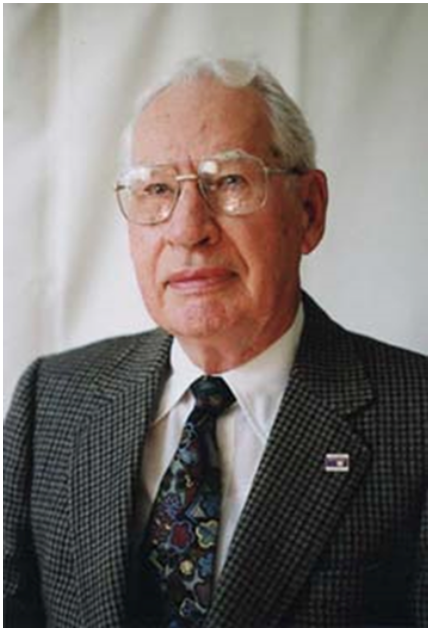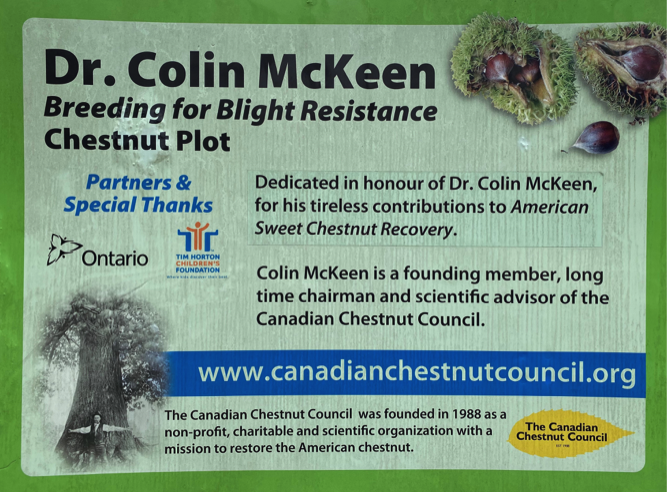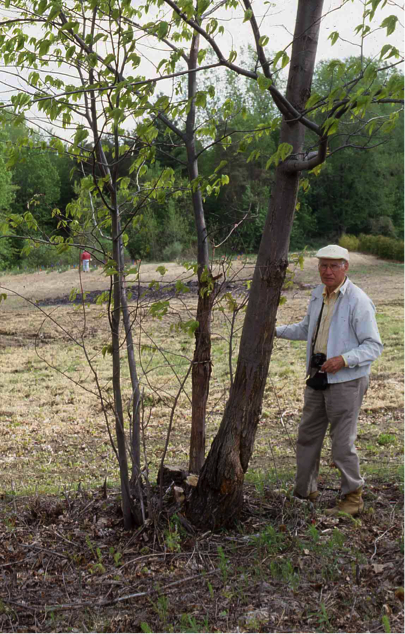Our Founder - Dr. Colin McKeen

Dr. Colin Douglas McKeen, 1916-2014
Founder of the Canadian Chestnut Council
Dr. Colin D. McKeen founded the Canadian Chestnut Council in 1988, primarily because of his interest in American chestnut and the devastation caused by chestnut blight that he had witnessed as a young man. He remained convinced that the application of scientific principles from disciplines such as botany, forestry and plant pathology could develop methods to manage this important disease and restore American chestnut to the forests of Ontario.
Early years
Colin D. McKeen was born on a farm near Strathroy, Ontario, on 23 June 1916, the fourth of six children. Colin received his B.A. degree from the University of Western Ontario in 1938 and won the Gold Medal in Botany. He obtained his M.A. in 1940 and Ph.D. in 1942 under Dr. D.H. Bailey at the University of Toronto. Following graduation and marriage to Beatrice in 1942, Colin enlisted with the Royal Canadian Core of Signals and served as a Lieutenant while stationed in London, England, during World War ll. Following the war, Colin returned to Canada and conducted postdoctoral studies at the University of Toronto with Dr. Bailey from 1945-46.
Colin’s First Career
In 1946, Colin joined the Plant Pathology scientific staff at the Harrow Research Station of Agriculture Canada and became involved in a broad program of research and extension on diseases of vegetable crops. Throughout his research and extension career at Harrow, Colin’s contributions to plant pathology were notable for their innovativeness, breadth and vision. His research involved fungi, viruses, bacteria, and nematodes, and his work on diseases caused by Fusarium and Verticillium earned him international recognition. In addition, his research on management of diseases of greenhouse tomato and cucumber was instrumental in helping to establish a greenhouse industry in Essex County, ON, making it a unique part of Canadian agriculture. His investigations also led to improved management of numerous important diseases in crops such as cantaloupe, cucumber, cucurbits, eggplant, onion, sweet pepper, potato and tomato. Colin published widely during his career on the results of his research on the causes and treatment of plant diseases and was internationally respected for his work. His practical approach to research resulted in significant increases in crop yields and he was highly regarded by growers, the agri-industry and fellow scientists.
Colin provided important leadership qualities throughout his career. He became Head of the Plant Pathology section of the Harrow Research Station in 1962 and, in 1973, moved to Ottawa as Coordinator for Phytopathology in the Research Branch of Agriculture Canada. In these positions he stimulated the development of plant pathology in Canada at both provincial and national levels. He was appointed Head of Crop Protection Coordination in 1976 and held that position until his retirement in December 1978. These experiences provided Colin with an opportunity to become familiar with the diversity of people and agriculture across Canada.
Colin also served the Canadian Phytopathological Society with distinction from 1947 to 2014. He was President of the Society in 1969-70, and facilitated publication of the historical treatise Plant Pathology in Canada by I.L. Conners by the Society in 1971. Colin also served as the first Editor of the Canadian Journal of Plant Pathology which has subsequently gone on to become one of the most important publications of CPS. In 1979, he was invited to address the plenary session of the CPS Golden Anniversary meeting in Lethbridge, Alberta. Colin was honored as the first Fellow of CPS in 1981. In later years, Colin continued to contribute as an Emeritus member of CPS.
On April 5, 2012, Colin was inducted into the Essex County Agricultural Hall of Fame at Harrow, ON, in recognition of his substantial contributions to plant health and disease management of field and greenhouse vegetable crops at the Harrow Research Station from 1946 to 1973.
Colin was also a strong believer in the importance of community service and served as a school board trustee, Chair of the Board of Harrow United Church, Gesstwood Retreat Centre and Camp, and Dominion Chambers United Church in Ottawa.
Colin’s Second Career and the Canadian Chestnut Council
Colin had always been aware of American chestnut (Castanea dentata) and chestnut blight as a young boy growing up in Strathroy, ON, and then later when he lived and worked in Harrow, ON. These areas were in the middle of the native range of American chestnut, a native tree in the Carolinian zone of southern Ontario, and would have been a common tree species in the forests and farmlands where he grew up and lived. This tree had been decimated due to the introduction of the fungal plant pathogen known as Cryphonectria parasitica in the mid-1920s. This pathogen caused the lethal disease known as Chestnut blight, and was responsible for the devastation of this tree from being a common member of the forests of southwestern Ontario to that of a rare species throughout Ontario after the epidemic. Colin remembered the destruction of this tree caused by Chestnut blight and always felt there was something more that could be done to help it recover.
Following retirement in 1978, Colin became committed to the on-going plight of American chestnut, and became “a tireless champion” of efforts to restore American chestnut in Canada. In these years, Colin spent many hours corresponding with anyone and everyone who had an interest in American chestnut. During the spring, summer and autumn months, Colin and Beatrice spent hundreds of hours driving around southwestern Ontario to follow up on reports of possible surviving chestnut trees. Individual trees were examined, and notes were kept on the location, landowner, size and health of each tree. Individual pins that represented each tree were put into a cardboard-mounted map of southwestern Ontario. Using this approach, Colin started to realize how many surviving chestnut trees were still present in Ontario and how many people were still interested and supportive of this tree. Based on these results, Colin founded the Canadian Chestnut Council (CCC) in 1988 and served as the Chair for 19 years. Enthusiasm for American chestnut and the role of the CCC continued to grow during these early years of the CCC.
In subsequent years Colin and other volunteers were able to identify and document more and more examples of surviving American chestnut trees throughout the native range in southwestern Ontario. Colin invited friends and former colleagues from his scientific career to help by joining the Board of Directors of the CCC. The annual meetings of the CCC became a focal point for Colin, his wife Beatrice, and the Board of Directors to meet with anyone who had an interest in this species. The program each year featured anecdotal comments and progress reports from within Ontario and presentations by invited speakers from Canada and the United States. And each year there were samples and prizes of “all things chestnut”, including nuts, seedlings, and hand-crafted samples of wood-working using chestnut wood that had been recovered from dead trees. Many of these activities were summarized in the Newsletters of the Canadian Chestnut Council that were published regularly from Issue #1 in February 1990 to Issue #78 in December 2021, and afterwards. In addition to news and activities of the CCC, the newsletters often listed the Executive, Board of Directors and Regional Representatives, and Honorary and Advisory Directors of the CCC. These newsletters and listings represent an impressive history of people and activity in support of American chestnut and the CCC through the decades, and are available on-line through the Canadian Chestnut Council website.
Awareness of the surviving populations of chestnut continued to spread through the efforts of Colin and the CCC. Eventually these efforts attracted the interests of scientific researchers such as botanists, plant ecologists, plant pathologists, plant breeders, and others that were employed in universities and the federal and provincial governments. These researchers initiated various research projects over time that focused on important topics such as more intensive surveys for the presence and health of the remaining populations of chestnut, using hypovirulence as a biological control strategy for chestnut blight, and trying to breed tolerance or resistance to chestnut blight into American chestnut. These researchers and their accompanying students added more enthusiasm and scientific perspective to the CCC. On an international level, interest in Endangered Species in Canada also became timely and, in 2007, American chestnut was listed as an Endangered Species under Ontario’s Endangered Species Act. A Recovery Strategy for American Chestnut was approved in 2012 with a goal to “… restore American Chestnut populations in Ontario to a self-sustaining state…”. This recovery strategy outlined many of the policies and procedures that could contribute to the restoration of American chestnut in Ontario. The CCC remains very active as the primary organization dedicated to fulfilling these recovery objectives for American chestnut, including a current emphasis on breeding American chestnut for tolerance or resistance to Chestnut blight. The original chestnut breeding nursery at Tim Horton Onondaga Farms, St. George, N, where this research was initiated was dedicated in Colin’s memory in 2009 (see photo).

Plaque acknowledging Dr. Colin McKeen’s dedication and commitment to the American Sweet Chestnut Recovery. This plaque was presented at the “Breeding for Blight Resistance Chestnut Plot” at the Tim Horton Onondaga Farm (THOF), St. George, ON, in 2009. (Photo by Ms. Christine Vey)
Summary
In summary, Dr. Colin McKeen had a highly successful career for 30 years as a Canadian research scientist with expertise in plant pathology and plant health. Following his retirement, he essentially embarked upon a second career of leading scientific efforts for the recovery of American chestnut in Ontario, and this second career continued for more than 35 years as both Chair and Director of the CCC. His contributions serve as a model for many others to emulate, and continually remind us that "Alone each of us can do a little – Together we can do much more." (original quote from Helen Keller).

"Alone each of us can do a little – Together we can do much more."
(Original quote from Helen Keller. Photo by Dr. Greg J. Boland)
Related Articles
Colin D. McKeen: Fellow of the Canadian Phytopathological Society. 1981. Canadian Journal of Plant Pathology 3:278.
McKeen, C.D. 1995. Chestnut blight in Ontario: past and present status. Canadian Journal of Plant Pathology 17:295-304.
In memoriam: Colin Douglas McKeen, 1916–2014. 2015. Canadian Journal of Plant Pathology 37 (2): 149-151.
* Much of this text was derived from “A celebration of the Life of Colin Douglas McKeen. June 23, 1916 to August 30, 2014”.
Article prepared by Dr. Greg J. Boland, 2021
Upcoming Events
There are no active events
Outreach & Education...
Various reports on the status of restoration efforts, tree population surveys, DNA analysis, breeding and propagation programs, etc.
The American Chestnut
- An Endangered Species
- Current Status in Canada
- Distribution in Ontario
- Chestnut Blight
- Identifying Chestnut Trees
- Found a chestnut/ Report a chestnut
- Have an American chestnut - Check its Pedigree
- Population dynamics and the influence of blight on American chestnut at its northern range limit: Lessons for conservation
Mission & History
- A Decade of Progress
- Recovery Plan
- Hypovirulence
- American Chestnut in Nova Scotia
- Resistance – Hope for the Future
- Breeding for Resistance
- Directors Past and Present
- Our Founder - Dr. Colin McKeen
 MEMBER LOG IN
MEMBER LOG IN


